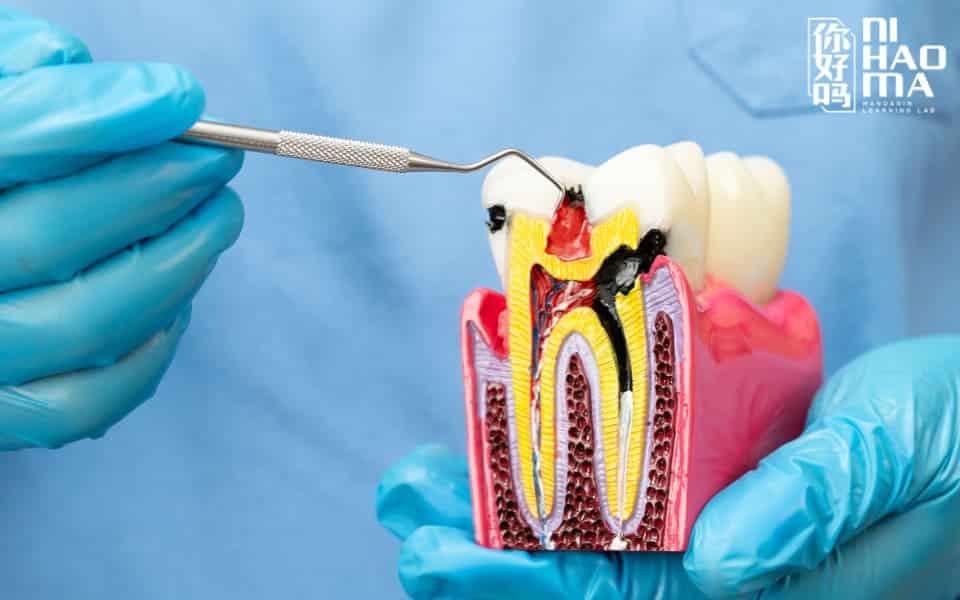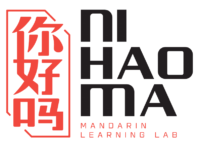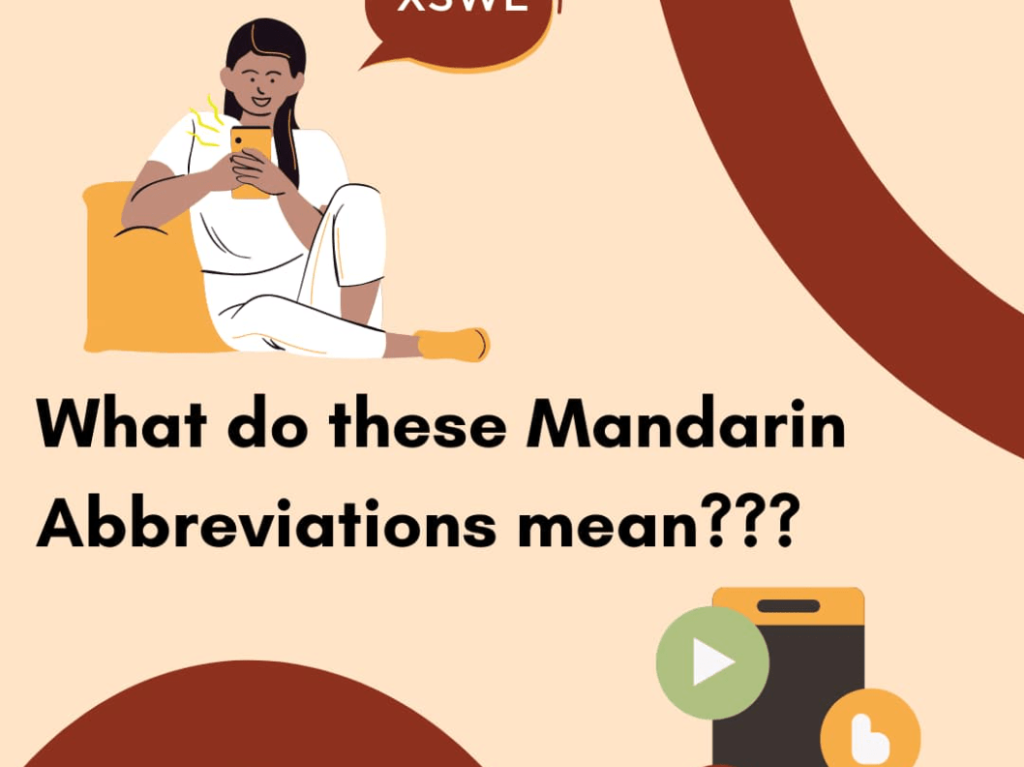Have you ever felt confused about how to say “toothache,” “scaling,” or “tooth filling” in Chinese? Dental care is a basic need in daily life, and for anyone living or working in a Chinese-speaking environment, understanding dental Chinese vocabulary is extremely important. In this guide, Ni Hao Ma introduces the most commonly used Chinese dental terms you’ll encounter in real-life situations — so you can describe your oral condition clearly, understand your dentist, and communicate with confidence. Let’s dive in!
Dental Chinese Vocabulary
In this section, we’ll explore the most practical dental Chinese vocabulary used in everyday situations. These words will help you describe dental symptoms, understand treatment instructions, and interact smoothly in dental clinics.
Dental Chinese Vocabulary for Job Roles in a Dental Clinic
In a dental clinic, each role has a specific responsibility—from dentists and orthodontists to dental assistants and receptionists. Knowing how to identify these roles in Chinese will help you communicate more effectively during appointments and consultations.
| Chinese | Pinyin | Meaning |
|---|---|---|
| 牙医 | yá yī | Dentist |
| 牙医助理 | yá yī zhùlǐ | Dental assistant |
| 护士 | hùshi | Nurse |
| 前台 / 接待员 | qiántái / jiēdàiyuán | Front desk / Receptionist |
| 医疗咨询师 | yīliáo zīxún shī | Treatment consultant |
| 正畸医生 | zhèngjì yīshēng | Orthodontist |
| 牙周科医生 | yázhōu kē yīshēng | Periodontist |
| 根管治疗医生 | gēnguǎn zhìliáo yīshēng | Endodontist |
| 口腔卫生员 | kǒuqiāng wèishēngyuán | Oral hygienist |

Dental Chinese Vocabulary for Common Dental Conditions
When you experience issues such as tooth decay, gum inflammation, or tooth sensitivity, being able to describe your symptoms clearly is the first step to receiving proper treatment. If you are communicating in Chinese, misunderstanding the vocabulary could lead to misdiagnosis. That’s why learning dental Chinese terms is so crucial.
| Chinese | Pinyin | Meaning |
|---|---|---|
| 牙疼 | yá téng | Toothache |
| 龋齿 | qǔchǐ | Tooth decay / Cavity |
| 牙龈炎 | yáyín yán | Gingivitis |
| 牙周炎 | yázhōu yán | Periodontitis |
| 智齿歪长 | zhìchǐ wāi cháng | Impacted wisdom tooth |
| 牙齿敏感 | yáchǐ mǐngǎn | Tooth sensitivity |
| 牙齿磨损 | yáchǐ mó sǔn | Tooth wear |
| 口臭 | kǒuchòu | Bad breath |
| 牙髓炎 | yásuǐ yán | Pulpitis |
| 牙齿脓肿 | yáchǐ nóngzhǒng | Dental abscess |
| 口干 | kǒugān | Dry mouth |
| 牙齿咬合不正 | yáchǐ yǎohé bùzhèng | Malocclusion |
| 牙齿变色 | yáchǐ biànsè | Tooth discoloration |
| 牙龈出血 | yáyín chūxiě | Gum bleeding |
Dental Chinese Vocabulary for Dental Examination Services
| Chinese | Pinyin | Meaning |
|---|---|---|
| 补牙 | bǔ yá | Tooth filling |
| 拔牙 | bá yá | Tooth extraction |
| 种植牙 | zhòngzhí yá | Dental implant |
| 洗牙 | xǐ yá | Teeth cleaning / Scaling |
| 美白牙齿 | měibái yáchǐ | Teeth whitening |
| 矫正牙齿 | jiǎozhèng yáchǐ | Orthodontic treatment / Braces |
| 口腔检查 | kǒuqiāng jiǎnchá | General oral examination |
| 根管治疗 | gēnguǎn zhìliáo | Root canal treatment |
| 牙齿贴面 | yáchǐ tiēmiàn | Dental veneer / Porcelain crown |
| 脱敏治疗 | tuōmǐn zhìliáo | Desensitization treatment |
| 牙科 X 光 | yákē X guāng | Dental X-ray |
| 做牙桥 | zuò yáqiáo | Dental bridge |
| 拔智齿 | bá zhìchǐ | Wisdom tooth extraction |
| 正畸 | zhèngjì | Orthodontics |
| 牙龈手术 | yáyín shǒushù | Gum surgery |
| 牙周治疗 | yázhōu zhìliáo | Periodontal treatment |
| 拆牙套 | chāi yátào | Braces removal |
| 安装牙套 | ānzhuāng yátào | Applying braces |
| 清洁牙缝 | qīngjié yáfèng | Interdental cleaning |
| 口腔评估 | kǒuqiāng pínggū | Oral health assessment |
| 复诊 | fùzhěn | Follow-up check |
| 麻醉 | mázuì | Anesthesia |
Dental Chinese Vocabulary for Dental Instruments & Supplies
These are the common tools and items found in every dental clinic. Knowing them makes communication during treatment easier and clearer.
| Chinese | Pinyin | Meaning |
|---|---|---|
| 牙刷 | yáshuā | Toothbrush |
| 牙膏 | yágāo | Toothpaste |
| 牙线 | yáxiàn | Dental floss |
| 漱口水 | shùkǒu shuǐ | Mouthwash |
| 牙科镜 | yákē jìng | Dental mirror |
| 探针 | tànzhēn | Dental probe |
| 牙科镊子 | yákē nièzi | Dental tweezers |
| 洗牙器 | xǐyá qì | Scaling tool |
| 牙钻 | yázuàn | Dental drill |
| 麻醉针 | mázuì zhēn | Anesthetic needle |
| 牙托 | yátuō | Dental retainer / Mouth guard |
| 牙套 | yátào | Brackets / Braces |
| 弓丝 | gōngsī | Orthodontic archwire |
| 拔牙钳 | báyá qián | Extraction forceps |
| 开口器 | kāikǒu qì | Mouth opener |
| 医用手套 | yīyòng shǒutào | Medical gloves |
| 医用口罩 | yīyòng kǒuzhào | Medical face mask |
| 器械盘 | qìxiè pán | Instrument tray |
| 牙科椅 | yákē yǐ | Dental chair |
| 牙科灯 | yákē dēng | Dental lamp |
| 牙科 X 光机 | yákē X guāngjī | Dental X-ray machine |
| 补牙材料 | bǔyá cáiliào | Filling material |
| 模型材料 | móxíng cáiliào | Impression material |
| 防护眼镜 | fánghù yǎnjìng | Protective eyewear |
| 冲牙器 | chōng yá qì | Water flosser |

Dental Chinese Vocabulary for Oral Anatomy
| Chinese | Pinyin | Meaning |
|---|---|---|
| 牙齿 | yáchǐ | Teeth |
| 口腔 | kǒuqiāng | Oral cavity |
| 牙龈 | yáyín | Gums |
| 舌头 | shétou | Tongue |
| 牙根 | yágēn | Tooth root |
| 牙釉质 | yáyòuzhì | Enamel |
| 牙本质 | yáběnzhì | Dentin |
| 牙髓 | yásuǐ | Dental pulp |
| 牙槽骨 | yácáo gǔ | Alveolar bone |
| 门牙 | ményá | Incisor |
| 犬齿 | quǎnchǐ | Canine tooth |
| 磨牙 | móyá | Molar |
| 前磨牙 | qiánmóyá | Premolar |
| 智齿 | zhìchǐ | Wisdom tooth |
| 乳牙 | rǔyá | Baby tooth |
| 恒牙 | héngyá | Permanent tooth |
| 上颌 | shànghé | Upper jaw |
| 下颌 | xiàhé | Lower jaw |
| 唇 | chún | Lips |
| 上颚 | shàng’è | Palate |
Related Topic You May Like: Chinese Body Parts Vocabulary with Examples
Dental Chinese Vocabulary in Daily Dialogues
Once you master the vocabulary, the next step is to use them naturally. The dialogue examples below help you handle real-life situations like toothache, booking dental service, and speaking with a dentist.
Conversation 1
A: 你怎么了?看起来有点难受。
Nǐ zěnmele? Kàn qǐlái yǒudiǎn nánshòu.
What’s wrong? You look a bit uncomfortable.
B: 我这几天牙一直在痛,晚上睡觉也被疼醒。
Wǒ zhè jǐ tiān yá yīzhí zài tòng, wǎnshang shuìjiào yě bèi téngxǐng.
My tooth has been hurting for the past few days. It even wakes me up at night.
A: 你有去看牙医吗?
Nǐ yǒu qù kàn yáyī ma?
Have you seen a dentist yet?
B: 还没有,我以为忍一忍就好了。
Hái méiyǒu, wǒ yǐwéi rěn yì rěn jiù hǎo le.
Not yet, I thought it would get better if I just endured it.
A: 牙痛一般不会自己好,可能是蛀牙或者发炎了,还是尽快去看看吧。
Yá tòng yìbān bú huì zìjǐ hǎo, kěnéng shì zhùyá huòzhě fāyán le, háishì jǐnkuài qù kànkan ba.
Toothaches usually don’t go away on their own. It may be a cavity or inflammation. You should see a dentist soon.
B: 你说得对,我等一下就预约牙科。
Nǐ shuō de duì, wǒ děng yīxià jiù yùyuē yákē.
You’re right. I’ll make a dental appointment later.

Conversation 2
A: 你好,这里是微笑牙科,请问有什么可以帮您?
Nǐ hǎo, zhèlǐ shì Wēixiào yákē, qǐngwèn yǒu shénme kěyǐ bāng nín?
Hello, this is Smile Dental Clinic. How can I help you?
B: 你好,我想预约本周的洗牙服务,请问最近有空的时间吗?
Nǐ hǎo, wǒ xiǎng yùyuē běnzhōu de xǐyá fúwù, qǐngwèn zuìjìn yǒu kòng de shíjiān ma?
Hi, I’d like to book a dental cleaning this week. Do you have any available time slots?
A: 请稍等,我查看一下……这周五上午十点有空,您方便吗?
Qǐng shāoděng, wǒ chákàn yīxià… Zhè zhōuwǔ shàngwǔ shí diǎn yǒu kòng, nín fāngbiàn ma?
One moment please… We have an opening at 10 a.m. this Friday. Does that work for you?
B: 可以的,周五十点我有空。请问大概需要多长时间?
Kěyǐ de, zhōuwǔ shí diǎn wǒ yǒu kòng. Qǐngwèn dàgài xūyào duō cháng shíjiān?
Yes, that works. How long will the cleaning take?
A: 整个过程大约三十分钟左右,如果有结石较多的话可能会稍微延长一点。
Zhěnggè guòchéng dàyuē sānshí fēnzhōng, rúguǒ jiéshí jiào duō kěnéng huì yáncháng yīdiǎn.
About 30 minutes. If there’s a lot of tartar, it may take a bit longer.
B: 好的,那就帮我预约这个时间,谢谢。
Hǎo de, nà jiù bāng wǒ yùyuē zhège shíjiān, xièxie.
Great, please book that time for me. Thank you.
A: 不客气,周五见,记得提前五分钟到哦。
Bú kèqi, zhōuwǔ jiàn, jìdé tíqián wǔ fēnzhōng dào o.
You’re welcome. See you on Friday. Please arrive 5 minutes earlier.

Conversation 3
A: 请坐。你哪里不舒服呢?
Qǐng zuò. Nǐ nǎlǐ bù shūfú ne?
Please have a seat. Where do you feel discomfort?
B: 我这几天左边的后牙一直痛,尤其是吃热的和甜的东西时。
Wǒ zhè jǐ tiān zuǒbiān de hòuyá yīzhí tòng, yóuqí shì chī rè de hé tián de dōngxī shí.
My left molar has been hurting these days, especially when I eat hot or sweet foods.
A: 让我看看……嗯,你这颗牙有蛀洞,已经比较深了,需要补牙。
Ràng wǒ kànkan… En, nǐ zhè kē yá yǒu zhù dòng, yǐjīng bǐjiào shēn le, xūyào bǔ yá.
Let me check… You have a cavity, and it’s quite deep. You’ll need a filling.
B: 补牙会疼吗?我有点害怕。
Bǔ yá huì téng ma? Wǒ yǒudiǎn hàipà.
Will it hurt? I’m a little scared.
A: 我们会给你打局部麻醉,过程基本不会痛,只是会有一点点酸胀感。
Wǒmen huì gěi nǐ dǎ júbù mázuì, guòchéng jīběn bú huì tòng, zhǐshì huì yǒu yīdiǎndiǎn suānzhàng gǎn.
We’ll apply local anesthesia. It won’t really hurt—just a slight pressure or soreness.
B: 那需要几次治疗?
Nà xūyào jǐ cì zhìliáo?
How many treatments will it require?
A: 如果补牙结构完整,一次就可以完成。如果蛀得太深,可能需要做根管治疗。
Rúguǒ bǔ yá jiégòu wánzhěng, yí cì jiù kěyǐ wánchéng. Rúguǒ zhù de tài shēn, kěnéng xūyào zuò gēnguǎn zhìliáo.
If the tooth structure is fine, we can finish it in one session. If the cavity is too deep, you may need a root canal treatment.
B: 好的,那麻烦医生帮我治疗。
Hǎo de, nà máfan yīshēng bāng wǒ zhìliáo.
Okay, please help me proceed with the treatment.
Conclusion
Mastering dental Chinese vocabulary is the key to helping you feel more confident during dental check-ups and treatments in China or any Chinese-speaking country. We hope the vocabulary lists and example dialogues provided by Ni Hao Ma have given you a solid foundation to build on. Keep practicing regularly to turn these words and expressions into real communication skills. Don’t hesitate to apply them in everyday situations — the more you use them, the more fluent and natural you will become!



